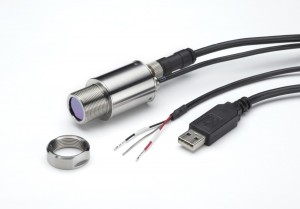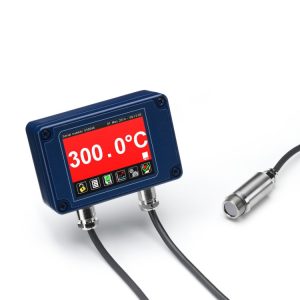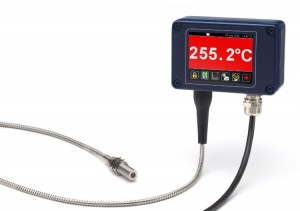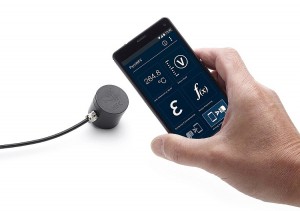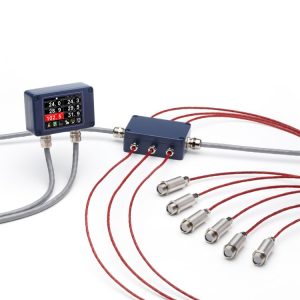5 Fully Configurable Infrared Temperature Sensors and When to Use Them
Powerful processing features are available on many Calex infrared temperature sensors as standard. Learn more about these features, and some of the sensors that provide them.
The Settings
Emissivity Setting
Emissivity is a measure of how effectively a surface emits infrared radiation. For an accurate temperature measurement, the emissivity setting of the sensor must match the actual emissivity of the surface. An adjustable emissivity setting allows the sensor to be set up to correctly measure a variety of surfaces.
Averaging
Infrared temperature sensors have a very fast response time – typically a fraction of a second. If the temperature of the target object changes slowly, and there is no need for an instantaneous response, the sensor’s output can be smoothed out and slowed down using the Averaging setting for a steadier measurement.
Peak/Valley Hold Processing
When measuring individual objects on a conveyor, the measurement will be meaningless while there is no object in view. With peak or valley hold processing, the sensor can ignore the meaningless low or high reading in the gaps.
Reflected Energy Compensation
To accurately measure objects inside an oven or furnace with a sensor positioned outside, the temperature inside the oven or furnace can be given to configurable sensors so they can compensate for reflected energy.
Five Configurable Sensors
All of these sensors have all the above settings. The sensors vary in their output type, measurement wavelength, and the range of ambient temperatures they can withstand.
- PyroUSB
Outputs available: 4-20 mA (two-wire), USB
Type: General-purpose (8-14 µm), short-wavelength (2.2 µm)
The PyroUSB is a compact, one-piece sensor with a loop-powered analogue output for direct connection to industrial monitoring equipment. It’s available with an optional cooling jacket (for use with a supply of air or water in applications where the ambient temperature is high), and is supplied with a removable USB cable for configuration. Changing the settings is easy with Calex software.
PyroUSB sensors are available with a choice of measurement wavelengths. Long-wavelength sensors are suitable for general-purpose use, measuring non-reflective non-metallic materials. They can also measure metals if they are painted. Short-wavelength sensors provide better accuracy in high-temperature applications and when measuring iron and steel surfaces.
- PyroMini
Outputs available: 4-20 mA (four-wire), RS485 Modbus
Type: General-purpose (8-14 µm), short-wavelength (2.2 µm)
A bright touch screen display (optional) provides the operator with a clear temperature reading, and the display can be configured to turn red in an alarm condition. Optional high-ambient sensing heads withstand operating temperatures of up to 180°C, making the PyroMini ideal for heat curing, drying and thermoforming applications.
- FibreMini
Outputs available: 4-20 mA (four-wire), RS485 Modbus
Type: Short-wavelength (2.2 µm) for high-temperature applications
The FibreMini has a fibre-optic sensing head that withstands 200°C ambient temperature without cooling, and its short measurement wavelength allows accurate measurements from 250°C to 2,000°C. Laser sighting is built in as standard. The laser uses the same lens as the IR measurement, showing the size of the measurement area while the temperature is being read.
- PyroNFC
Outputs available: Voltage, Type K Thermocouple
Type: General-purpose (8-14 µm)
For a small, low-cost configurable sensor in general-purpose industrial applications, look no further than the PyroNFC. Temperatures from 0°C to 1,000°C can be measured, and a choice of voltage or thermocouple output types is available, making it easy to replace traditional contact probes.
When measuring non-reflective non-metals, the sensor will work straight out of the box with default settings, and configuration is made easy with a free Android app. Reading and writing settings via NFC is possible with no need to even connect power to the sensor.
- PyroMiniBus
Outputs available: RS485 Modbus communications
Type: General-purpose (8-14 µm)
A network of digital sensors provides a powerful and cost-effective way to measure multiple points. Cabling is minimised, and centralised data collection and monitoring is made easy. RS485 Modbus is a simple, robust, industrial standard and the ideal basis for multi-channel temperature monitoring using the PyroMiniBus. Reading the temperatures and configuring the sensors is straightforward via Modbus commands.
And That’s Not All
These five sensors cover a huge range of industrial applications, but our full product range provides even more capabilities than that. Why not browse our product range or get in touch with us if you have any questions?

